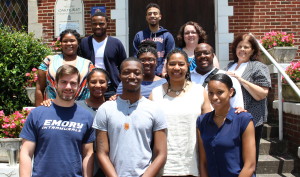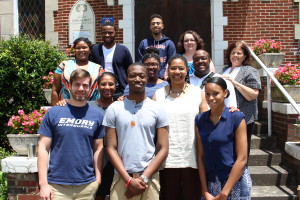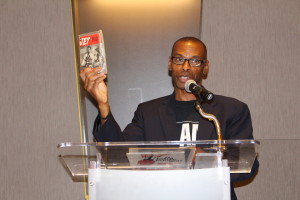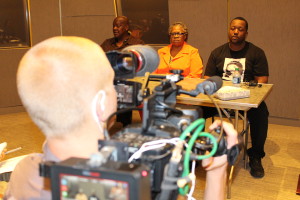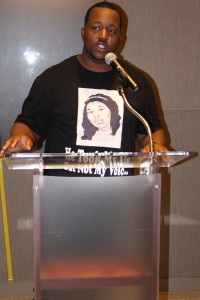National Archives Museum Reflection
by Ibrahim Lawton
As I looked at the Constitution, the first thing that came to my mind was that this document, that is supposed to guarantee certain rights and freedoms, was never intended to include me in it. I thought about the strides that many Black men and women have taken to help give Black people the rights that we as humans also deserve. As a future lawyer, these are the documents that I must learn to use to my advantage in dismantling White supremacy and achieving social justice. I believe it is important that I understand the history of these documents to help continue on the path many Black leaders have begun, advocated for and died for.
Two of the most successful Black lawyers that were able to use the law to their advantage in both politics and business were Thurgood Marshall and Reginald Lewis. Thurgood Marshall grew up in Baltimore, Maryland, and overcame the obstacles of living in an era that hated and killed Black people for any reason to be deemed by society as reasonable allowing him to become the most influential lawyer of his time. Reginald Lewis also overcame the struggles of growing up as a poor Black child from Baltimore with nothing, to becoming the first Black billionaire in America. I understand that the success of these Black men, as well as other Black men and women, was far from easy. Like other successful African Americans, they were masters at their crafts, specifically in areas of business and law. They understood and studied how white supremacy functioned specifically in their areas of expertise, then learned ways how to dismantle and overcome the obstacles they faced. The success that these two men had, while being under the scrutiny of a white supremacist system, show me that it is possible to maneuver and advocate successfully in America for the masses of Black people and for themselves individually. I believe that by continuing to study history, the law, and how others were able to use these tools to help liberate Black people, I can pick up the torch and continue to carry it.
It is appalling to me that even after centuries since the making of the Declaration of Independence, the Constitution, the Bill of Rights, and the evolution of the law since the creation of these documents, to this day Black people are still denied the most basic human rights. I have respect for all of these documents, but at the end of the day they are still just that – documents. Pieces of paper. I say that because even after laws such as the Reconstruction Amendments were passed, they still did not guarantee any substantive rights to Black people. Although the laws did look good on paper, the lack of enforcement and implementation of these laws rendered them ineffective for along time. After the passing of those amendments, Black people were still unable to vote, they were still denied entry to institutions, as well as many other denials.
Many people believe that laws such as the 13th, 14th and 15th amendments and the civil rights laws were made for Black people. That is false. As a Black man, I of course know that I am Black, I know I am human and I know that as a Black human I should have the right to vote, eat where I want and be treated fairly. We as Blacks already know that. Those laws however, were made for White people who have always oppressed non-whites. Those laws had to be created to tell White people “do not deny that Black man/woman their rights,” “do not discriminate against that Black man/woman.”
For example, the Voting Rights Act was one of the single most influential pieces of legislation that benefitted Black people. However, the Supreme Court recently struck down section 4 of the Voting Rights Act in Shelby County, Ala. vs. Holder in 2013. This section had required nine southern states to gain approval from the DOJ before making any changes to voting laws in their state. It is important to keep in mind that history has shown these states to practice the most racial tactics to disenfranchise people of color for decades. Shortly after this section was struck down, the Voter ID Act was passed in Texas, which placed an unconstitutional burden on over 500,000 Black people that were previously eligible to vote, and rendered them ineligible to vote in the 2014 gubernatorial elections. Time has shown that the racist system we live in, is still evolving in ways to disenfranchise and deny Black people our rights.
With the Fourth of July only a few days away, this may be a prime example to highlight one of the different ways in which laws have more significance in meaning for Whites than for Blacks. Although both Blacks and Whites fought the British to obtain freedom and liberation, after the war only Whites were free while Blacks remained enslaved. The signing of the Declaration of Independence and the Fourth of July did not guarantee freedom and independence for Blacks. Frederick Douglass may have said it best during a speech in 1852:
What, to the American slave, is your 4th of July? I answer; a day that reveals to him, more than all other days in the year, the gross injustice and cruelty to which he is the constant victim. To him, your celebration is a sham; your boasted liberty, an unholy license; your national greatness, swelling vanity; your sounds of rejoicing are empty and heartless…
As Black people, we must begin to educate ourselves to understand how White supremacy functions in all areas of people activity, so that we may begin to effectively counter and dismantle a racist system and have true justice and peace.
by Karen Bryson
The National Archives is a museum and research facility erected to celebrate America’s uncanny ability to keep records, to document events, and to memorialize the past. The Archives is filled with all kinds of documentation and prides itself on housing, maintaining, and accounting for this information, from having the Magna Carta on display, to records documenting the ongoing struggle of Americans to define, attain, and protect their rights. From baby photos of former presidents and first ladies, to gifts from Heads of State and beyond, the Archives has it. In elementary school did you ever write a letter to the President? If you answered yes, then the National Archives claims to even have all letters, including children’s letters, written to the President too. The National Archives is America’s time capsule. It is the nation’s history recorded. So generations from now, our children’s children will know the principles and people that help create the society they live in.
Among the abundance of information, are subtleties that are easy to overlook. The underlying racism, sexism, and other prejudices engrained in our foundation are also memorialized in ink and exhibitions at the Archives. Video clips of the Women’s Suffrage movement, documentation showing that even after the Emancipation Proclamation was issued by President Lincoln enslaved persons, all over the country, were not freed for months and even years after signing, and accounts of discrimination and injustice of immigrants from all over the world can be found inside the Archives.
When looking at the Archives in the most favorable light, I put on my rose colored glasses. Through my rose colored glasses, I was amazed at the history and information stored in one historic and protected place. Through my rose colored glasses, I saw the important statement the United States was making by not only displaying its triumphs, but also revealing America’s shortcomings. Through my rose colored glasses, I took note of how the financial burden, potentially barring access to this information, had been lifted by making the National Archives a part of the Smithsonian and not charging an entry fee. The US has made this rich and valuable resource open to the public and available to all.
The National Archives is particularly useful in furthering along the work of the Cold Case Justice Initiative (“CCJI”). CCJI primarily investigates cold cases dealing with racially motivated killings and disappearances of African Americans during the Civil Rights Era and advocates for families to law enforcement. CCJI also participates in victim identification and creating and maintaining a count of these deaths and disappearances, as such a list has never been accurately documented by our government. CCJI is also actively pursuing the amendment and extension of the Emmett Till Unsolved Civil Rights Crime Act signed into law in 2008. The Library of Congress summarizes the Emmett Till Act to say,
“Emmett Till Unsolved Civil Rights Crime Act – Directs the Attorney General to designate a Deputy Chief in the Criminal Section of the Civil Rights Division of the Department of Justice. Makes the Deputy Chief responsible for investigating and prosecuting violations of criminal civil rights statutes in which the alleged violation occurred before January 1, 1970 and resulted in death.[1]
Section 5
Authorizes the Attorney General to award grants to state or local law enforcement agencies for the investigation and prosecution of violations of state or local laws that are similar to the federal criminal civil rights statutes. Authorizes appropriations.[2
Section 8
Terminates the effectiveness of the above provisions at the end of FY2017.”[3]
CCJI would like to see this act expanded. For starters, civil rights crimes did not end January 1, 1970; so neither should the authority to investigate these crimes. Second, the act is set to end in 2017 and the work is incomplete. Hundreds or thousands of victims have yet to be acknowledged and accounted for by the government and of those the government has acknowledged, few cases are still open. As for the cases that have been closed, little effort to seek justice has been shown by the government. Cases are being closed with insufficient investigation. No one bothered to interview the family, no one bothered to question the living witnesses, criminal documents from the 1960’s mysteriously come up “missing” without further investigation, and other investigational mistakes are taking place. After a less than thorough investigation, the Department of Justice (“DOJ”) makes an inconclusive determination to close the case. Because of this, CCJI would like to amend The Emmett Till Act to require more than a mandatory annual report sent to Congress about the work of the Justice department. CCJI requests more rigid requirements be put in place before DOJ is able to close a case. The government should require results; evidence of thorough investigations, prosecutorial involvement, and documentation of new developments and additional cases and victims that have been uncovered during their search for the truth.
As I remove my rose colored glasses and see the Archives, flaws and all, I see the disparities in documentation. I see the undervaluation of slain African Americans here in this country across the spectrum where, on one hand, America does not denounce the existence of slavery while on the other hand America does not negate that African Americans were treated unequally during the civil rights era. However, even this latter recognition falls short of truthfully describing the horrific racist acts that took place.
Many of these unspeakable acts were not thoroughly documented, but even some of the well-documented acts, like the Mustard Gas Experiments performed on American soldiers of color are withheld from display. The mustard gas experiments were secret World War II chemical experiments where African American soldiers were locked in wooden chambers as mustard gas was piped inside to see its affects on humans. Sixty thousand (60,000) documented soldiers were apart of this heinous testing, which included gas chambers, pouring mustard gas directly on one’s skin, and field tests where soldiers were exposed to mustard gas outdoors. Most were soldiers of color. The soldiers were sworn to secrecy and the government kept these experiments classified until 1991 when federal officials formally admitted to these acts of torture, declassified and published reports on the types of experiments conducted. The parallels between these types of experiments conducted on Black, Latino, and Asian soldiers, and the atrocities committed during the Holocaust are chilling. However, gruesome acts like this and hundreds of other unpublicized acts of abuse and violence perpetrated against people of color in this country are not recognized in the Archives, demonstrating racial disregard.
Without my rose colored glasses clouding my vision, I recognize the gaping holes in the picture painted in the Archives. There is no accurate count of the hate crimes committed in this country. There is no recognition of the countless unsolved murders of African Americans. The government did not even bother to attempt to gather an unabridged list of names of African Americans who were slaughtered due to senseless racial hatred and since denied justice through the criminal justice system. The US did not acknowledge the hundreds or thousands of disappearances that plagued African American communities. Even today, 2015, our government continues to lie or trivialize the damage done by white superiority ideology.
With my rose colored glasses removed, I see the vital need of CCJI’s work. Simply compiling a list of names never acknowledged by the Government, not deemed important enough to make it into the National Archives, is monumental. Creating an effective process for providing justice to the families who have lived with the pain of losing a loved one and the hurt of their government turning their backs on them in their time of need. This work is important and must be documented.
The National Archives is an important monument of information and of acknowledgement that these things happened and are important enough to remember. CCJI is fighting to ensure that no matter your race, sex, or religion, you are remembered.

